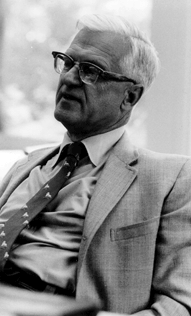
シャーウッド・ウォシュバーン
Sherwood Larned Washburn, 1911-2000

☆ シャーウッド・L・ウォッシュバーン(1911年11月26日 - 2000年4月16日)は、「シェリー」という愛称で呼ばれたアメリカの自然人類学者であり、「その分野における伝説的人物」であった。[1] 彼は霊長類学の分野における先駆者であり、霊長類を自然環境下で研究する道を開いた。ヒトの起源に関する理論と霊長類の行動の比較分析における彼の研究と 影響力は、人類進化の分野における研究に新たな方向性を打ち立てた。彼は1951年に発表した論文『The New Physical Anthropology』で、人類の多様性は連続的であり、不連続な人種に分けることはできないと説得力を持って論じ、人類学の分野に大きな変化をもた らした。
| Sherwood Larned
Washburn (November 26, 1911 – April 16, 2000), nicknamed "Sherry", was
an American physical anthropologist, and "a legend in the field."[1] He
was pioneer in the field of primatology, opening it to the study of
primates in their natural habitats. His research and influence in the
comparative analysis of primate behaviors to theories of human origins
established a new course of study within the field of human evolution.
He changed the field of anthropology with the publication of his paper
The New Physical Anthropology,[2] in 1951, in which he argued,
convincingly, that human variation was continuous, and could not be
broken up into discontinuous races.[1] |
シャーウッド・L・ウォッシュバーン(1911年11月26日 -
2000年4月16日)は、「シェリー」という愛称で呼ばれたアメリカの自然人類学者であり、「その分野における伝説的人物」であった。[1]
彼は霊長類学の分野における先駆者であり、霊長類を自然環境下で研究する道を開いた。ヒトの起源に関する理論と霊長類の行動の比較分析における彼の研究と
影響力は、人類進化の分野における研究に新たな方向性を打ち立てた。彼は1951年に発表した論文『The New Physical
Anthropology』で、人類の多様性は連続的であり、不連続な人種に分けることはできないと説得力を持って論じ、人類学の分野に大きな変化をもた
らした。 |
| Biography He was born and raised in Cambridge, Massachusetts to Henry Bradford Washburn Sr., dean of the Episcopal Theological School in Cambridge, and Edith Buckingham Hall. He was the younger brother of Henry Bradford Washburn. In his youth, Washburn took a keen interest in the field of natural history, and during school vacations worked with exhibits and collections in Harvard's Museum of Comparative Zoology. Washburn graduated summa cum laude from Harvard University with a bachelor's degree in Anthropology in 1935, followed by a Ph.D. in anthropology in 1940. For a time, Washburn considered pursuing his doctorate in zoology, and in his first year in graduate school, worked as an assistant with a zoological expedition in southern Asia called the Asiatic Primate Expedition. His work as a graduate student in comparative anatomy, comparative psychology, animal locomotion mechanics, and paleontology helped shape in him a multi-disciplinary perspective toward the study of evolutionary origins. Washburn married Henrietta Pease in 1938, and they had two children, Sherwood "Tuck" and Stan. They subsequently resided in New York, Chicago, Illinois and Berkeley, California, where Sherwood held university positions. Washburn died in Berkeley in 2000 at age 88. |
経歴 マサチューセッツ州ケンブリッジで、ケンブリッジにある米国聖公会神学校の学長ヘンリー・ブラッドフォード・ウォッシュバーン・シニアとエディス・バッキ ンガム・ホールの間に生まれ育つ。ヘンリー・ブラッドフォード・ウォッシュバーンの弟である。ウォッシュバーンは若い頃、自然史の分野に強い関心を抱き、 学校の休暇中はハーバード大学の比較動物学博物館で展示物やコレクションの管理を手伝っていた。 ウォッシュバーンは1935年にハーバード大学を人類学の学士号を取得して首席で卒業し、1940年には人類学の博士号を取得した。ウォッシュバーンは一 時、動物学の博士号取得を検討し、大学院の1年目には、アジア霊長類探検隊と呼ばれる南アジアの動物学探検の助手として働いた。大学院生として比較解剖 学、比較心理学、動物の運動力学、古生物学を研究したことが、進化の起源の研究に対する多分野にわたる視点を彼に形成させた。 ウォッシュバーンは1938年にヘンリエッタ・ピースと結婚し、2人の子供、シャーウッド・「タック」とスタンをもうけた。その後、一家はニューヨーク、 シカゴ、イリノイ、そしてシャーウッドが大学で教鞭をとっていたカリフォルニア州バークレーに住んだ。ウォッシュバーンは2000年にバークレーで88歳 で死去した。 |
| Harvard Washburn entered Harvard's graduate program with the intention of pursuing a doctorate in zoology. His focus shifted to anthropology after being induced to attend an introductory seminar on the subject led by his freshman advisor and close family friend Alfred Tozzer. Finding the mixture of archaeology, customs and human evolution stimulating, he joined the physical anthropology program led by Earnest Hooton where he was able to enfold his zoological coursework such as comparative anatomy and paleontology in his approach to the study of human evolution. Doctoral students in Harvard's physical anthropology program were forced to look beyond the anthropology department to secure the necessary training, which Washburn considered fortuitous because the experience left him with deep appreciation how much more can be learned when a multidisciplinary effort is brought into the analysis. While studying for his doctorate, Washburn received his first opportunity to engage in fieldwork. He served as an assistant zoologist in Harold J. Coolidge's 1935–1936 Asiatic Primate Expedition. In Malaysia he helped collect specimens of various species of colobine and macaque monkeys and the orangutan. In Sri Lanka and Thailand he also collected specimens of lar gibbon and observed their behavior in natural surroundings. He continued this work on the collection when he returned to Harvard, at times assisted by Gabriel Lasker. Washburn would later credit the ongoing discussions between Lasker and himself during this period (1938) as formative to his views about human variability. To Washburn, human variability was to be understood in terms of population genetics, and not according to the terms of racial and constitutional typology as typified by his doctoral advisor, Hooton.[3][4] His doctoral thesis was a metrical appraisal of proportions in the skeletons of adult macaques and langurs. His doctorate, awarded in 1940, was the first from Harvard's anthropology department to be awarded for a study of non-human primates.[3] |
ハーバード ウォッシュバーンは、動物学の博士号取得を目指してハーバード大学の大学院に入学した。しかし、新入生アドバイザーであり、家族とも親しい友人であったア ルフレッド・トッツァーが教える人類学入門セミナーに参加するよう勧められたことをきっかけに、専攻を人類学へと変更した。考古学、風習、人間進化の混合 に刺激を受け、彼はアーネスト・フートンが率いる自然人類学プログラムに参加した。そこで、比較解剖学や古生物学といった動物学のコースワークを、人間進 化の研究に活かすことができた。ハーバード大学の自然人類学プログラムの博士課程の学生は、必要なトレーニングを受けるために人類学部以外の場所にも目を 向けなければならなかった。ウォッシュバーンは、この経験から、学際的な取り組みが分析に導入されたときに、どれほど多くのことを学べるかを深く理解し た。 博士号取得に向けた研究中に、ウォッシュバーンは初めてフィールドワークに従事する機会を得た。1935年から1936年にかけて、ハロルド・J・クー リッジが率いるアジア霊長類探検隊で動物学者のアシスタントを務めたのだ。マレーシアでは、コロブス属やマカク属のサル、オランウータンの標本収集を手 伝った。スリランカとタイでは、テナガザルの標本収集と自然環境下での行動観察も行った。ハーバード大学に戻ってからも、ガブリエル・ラスキンに手伝って もらうこともありながら、この収集作業を続けた。ウォッシュバーンは、この時期(1938年)にラスキンと自分との間で交わされた継続的な議論が、人間の 多様性に関する自身の考えを形成する上で重要であったと後に述べている。ウォッシュバーンにとって、人間の多様性は集団遺伝学の観点から理解されるべきも のであり、彼の博士課程の指導教官であるフートンが代表するような人種や体質の類型論の観点から理解されるべきものではなかった。 彼の博士論文は、大人のマカク属とランガールの骨格における比率を韻律で評価したものだった。1940年に授与された彼の博士号は、ハーバード大学の人類 学部から授与されたもので、人間以外の霊長類の研究に対して授与された最初の博士号であった。 |
| Career Upon graduating Harvard, Washburn accepted a position as associate professor of anatomy in Columbia University College of Physicians and Surgeons, where he remained for eight years. From 1947 to 1958 he was a professor of anthropology at the University of Chicago, for a time serving as department chair. He left the University of Chicago for a professorship in University of California, Berkeley, where he remained until his retirement in 1979. In 1975 the university elected him to the appointment of University Professor, one of 35 such appointments granted since the position was first created in 1960.[5] Published works Social Life of Early Man, New York, Viking Fund, 1961 Evolution of a Teacher Annual Review of Anthropology. 1983. "The Evolution of Man", Scientific American v239 n3 p194–208 September 1978 Human evolution: Biosocial perspectives, edited with Elizabeth McCown, Menlo Park, California: Benjamin/Cummings Pub. Co. 1978 Ape Into Man; A Study of Human Evolution, Boston: Little, Brown. 1973. |
キャリア ハーバード大学を卒業後、ウォッシュバーンは、コロンビア大学医学部の解剖学の准教授に就任し、8年間その職に留まった。1947年から1958年までは シカゴ大学の自然人類学の教授を務め、一時、学科長も務めた。その後、シカゴ大学を去り、カリフォルニア大学バークレー校の教授職に就き、1979年に退 職するまでその職に留まった。1975年には、同大学は彼をユニバーシティ・プロフェッサーに選出した。この職は1960年に創設されて以来、35名しか 任命されていない。 出版作品 『初期人類の社会生活』、ニューヨーク、Viking Fund、1961年 『教師の進化』、『Annual Review of Anthropology』、1983年 「人類の進化」、『サイエンティフィック・アメリカン』第239巻第3号、1978年9月、194-208ページ 「人類の進化:生物社会学的視点」、エリザベス・マッカウンとの共編著、カリフォルニア州メンローパーク:ベンジャミン/カミングス出版、1978年 『サルから人へ:人類進化の研究』、ボストン:リトル・ブラウン、1973年 |
| https://en.wikipedia.org/wiki/Sherwood_Washburn |
|
リ ンク
文 献
そ の他の情報
Copyleft, CC, Mitzub'ixi Quq Chi'j, 1996-2099
☆
 ☆
☆